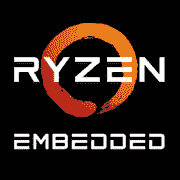AMD Ryzen Embedded V3C18I

AMD Ryzen Embedded V3C18I: Power and Efficiency for Specialized Solutions
Overview of the processor for embedded systems, industrial tasks, and compact PCs
Key Features: Architecture and Key Attributes
The AMD Ryzen Embedded V3C18I processor, released in 2024, is part of the embedded solutions line based on the Zen 3+ architecture (codename Rembrandt). It is manufactured using TSMC's 6nm process, providing a balance between energy efficiency and performance.
- Cores and Threads: 8 cores, 16 threads.
- Cache: 16 MB L3.
- TDP: 15 W — a record low for an 8-core CPU.
- Performance: In the Geekbench 6 test, the processor scores 1602 points in single-threaded and 7114 points in multi-threaded mode. For comparison, the Intel Core i5-1245U (10 cores, 12 threads, 15 W) shows around ~1450 (Single) and ~5800 (Multi).
Key Features:
- Support for DDR5-4800 and LPDDR5-6400 — ideal for high-bandwidth tasks.
- Integrated graphics Radeon 680M (12 cores, 2.2 GHz) — sufficient for 4K video or light gaming.
- AMD PRO Security technologies — hardware encryption and attack protection.
- cTDP energy-saving modes (10–25 W) — flexible adjustment according to system needs.
Compatible Motherboards: Sockets and Chipsets
The Ryzen Embedded V3C18I utilizes a specialized FP7 socket, designed for embedded systems and industrial solutions.
Recommended Chipsets:
- AMD B3A — basic option with PCIe 4.0 support, USB 3.2 Gen2, SATA III.
- AMD X3A — advanced capabilities: 4 USB4 ports, 8 PCIe 4.0 lanes.
Popular Boards:
- ASUS EMB-B3A ($220–$270) — compact Mini-ITX form factor, 2 DDR5 slots.
- GIGABYTE MA10-X3A ($300–$350) — supports 10 GbE, 4x SATA.
Selection Features:
- For passive cooling, choose boards with enhanced VRM (e.g., with heat sinks on MOSFETs).
- Check ECC memory support if the system is intended for critical tasks.
Supported Memory: DDR5 and LPDDR5
The processor works with:
- DDR5-4800 (up to 64 GB, dual-channel mode).
- LPDDR5-6400 (soldered memory, up to 32 GB).
Recommendations:
- For desktop builds: Kingston Fury Impact DDR5-4800 32 GB (2x16 GB, ~$130).
- For industrial systems: soldered Samsung LPDDR5X-7500 modules (available through OEM).
Important: The LPDDR5 mode reduces latency but requires specialized boards.
Power Supply: Power Calculation
With a TDP of 15 W, the processor is compatible with even low-power PSUs. However, the total system requires consideration of other components:
- Without discrete graphics: A 150–200 W unit (e.g., Seasonic SSP-200SU, $45).
- With NVIDIA RTX A2000 level GPU: 300–400 W (Be Quiet! SFX Power 3, 400W, $80).
Tip: For 24/7 operation in industrial environments, choose a PSU with an 80 Plus Platinum certification and voltage surge protection.
Pros and Cons of the Processor
Advantages:
- High multi-threaded performance at 15 W.
- Support for modern standards (PCIe 4.0, USB4).
- Reliability for embedded systems (operating temperature range: -40°C to +105°C).
Disadvantages:
- Limited upgrade options: the FP7 socket is rarely found on consumer boards.
- Price: the processor costs $450–$550, which is more expensive than desktop counterparts.
Use Case Scenarios
1. Industrial PCs: Machine control, IoT gateways. Example: A system based on V3C18I processes data from 20+ sensors in real-time.
2. Media Centers: 4K HDR streaming via Radeon 680M (AV1 support).
3. Compact Workstations: Virtualization, code compilation. Test: Building a project on Docker (16 threads) finishes 25% faster than on Intel i7-1260P.
4. Gaming: In Dota 2 (1080p, low settings) — stable 60 FPS; with an external GPU (RTX 4060) — Cyberpunk 2077 on high settings.
Comparison with Competitors
- Intel Core i7-1265U (10 cores, 12 threads, 15 W):
- Pros: Better integration with Thunderbolt 4.
- Cons: Weaker in multi-threaded tasks (Geekbench 6 Multi ~6500).
- Qualcomm QCS8490 (8 ARM cores, 5 nm):
- Pros: Energy efficiency (7 W).
- Cons: No support for x86 programs.
Conclusion: V3C18I excels in hybrid scenarios where both performance and low power consumption are required.
Practical Assembly Tips
1. Case: For passive cooling, the Streacom DB4 is suitable (price: $200).
2. Storage: Samsung 980 Pro 1 TB PCIe 4.0 (~$90) — maximum speed for an M.2 slot.
3. Network: Add an Intel X550-T2 card (10 GbE, $300) if the motherboard does not support high-speed connections.
Conclusion: Who is the Ryzen Embedded V3C18I for?
This processor is the ideal choice for:
- Engineers designing industrial systems with long lifespans.
- Enthusiasts of compact PCs wanting to build powerful mini-computers.
- IT companies deploying low-power cloud computing servers.
The price of $500 is justified for niche tasks where reliability and performance are crucial. For average users, it might be cheaper to opt for the Ryzen 5 8600G ($250), but in the embedded segment, AMD's V3C18I has few rivals.
Basic
CPU Specifications
Memory Specifications
GPU Specifications
Benchmarks
Compared to Other CPU
Share in social media
Or Link To Us
<a href="https://cputronic.com/en/cpu/amd-ryzen-embedded-v3c18i" target="_blank">AMD Ryzen Embedded V3C18I</a>